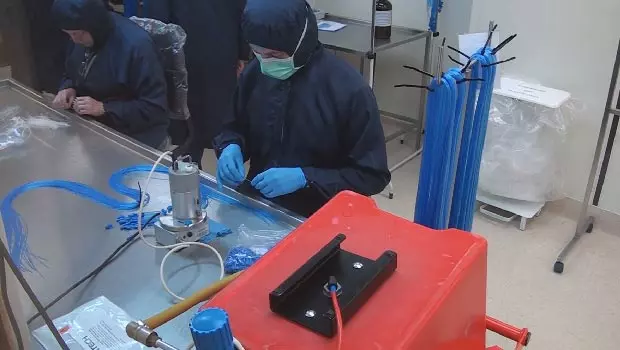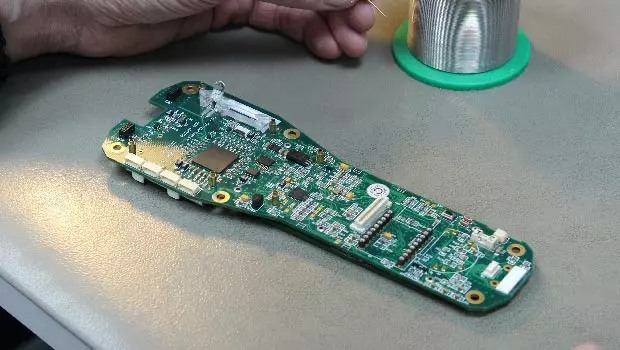MRP for Medical Manufacturers

While manufacturing products for the medical industry may entail similar processes and needs to those in other manufacturing sectors, the value to risk association is much greater. If mistakes happen during manufacturing, it doesn't just result in a product return - people can die. The stakes are so much higher and, as a result, the system required to manage manufacturing needs to be that much more robust.
Why do medical manufacturers need MRP software?
The keyword here is traceability. Everything must be traceable - which materials were used, which batch/supplier did they come from and who worked on them. Serial number tracking in components, batches and the finished part are essential. Materials that have a shelf-life must be traced to ensure that out of life products do not find their way into finished parts.
Manufacturing processes themselves will be much more stringent, often requiring controls to restrict which staff can perform certain operations.
Even subcontracting may have additional requirements. Companies will often send products out to subcontractors to be irradiated for sanitisation purposes, which of course must be tracked.
Case Study: An electronics company specialising in the medical sector moved to 123Insight after their existing MRP system was no longer supported. They now use tablets across the shop floor to book goods in/out or perform rolling stock checks, display production information live on the shop floor on LCD displays and have linked BOM and part master data to other external data systems, allowing 123Insight to be the main source for all data.
The keyword here is traceability. Everything must be traceable - which materials were used, which batch/supplier did they come from and who worked on them.
What are the quality standards in the medical industry?
The most important quality standard in the medical industry for devices and services related to them is ISO13485. It is a requirement for a quality management system where an organisation needs to demonstrate its ability to provide medical devices and related services that consistently meet customer and applicable regulatory requirements.
The ISO 13485 structure spans eight distinct sections. Sections 1, 2 and 3 introduce the standard. The remaining five contain the mandatory requirements for the Quality Management System (which any MRP system would be a significant part of), spanning documentation, management responsibility, resource management, product realisation and measurement, analysis, and improvement.
UK manufacturers that wish to sell into the NHS have another standard to contend with - GS1 compliancy. GS1 aims to improve patient safety, reduce unwarranted clinical variations and drive operational efficiencies. For manufacturers this can be summarised as needing globally unique identification numbers on products, machine-readable representation of data such as on labels, and a common standard of sharing business-critical information. A part of the GS1 approval certification process is a ‘system demonstration’, showing that the company has the required systems in place to meet the approval criteria.
Case Study: A disposable plastics medical equipment manufacturer replaced their five-year old system with 123Insight, implementing it in just two weeks. Ten years later they had seen a business increase of 50% but without increasing the number of administration staff. While regulations are much tighter than when the system was first implemented, the company is able to quickly generate the reports required.

How can MRP help quality for medical manufacturers?
Imagine the scenario of a product recall. A customer has contacted you and said that your last delivery contains faulty products. A good MRP system will immediately identify the serial numbers of the batch and all items in question. Next, you will be able to see the works order, covering the route it took through production, who worked on it and with which raw materials, back through to which suppliers delivered them.
Quality can be measured in many ways - the finished product, accuracy, and traceability of data, streamlining of processes, etc. MRP helps with all of these by providing a common platform and series of well-defined processes for the business to use that are in accordance with the requirements of one or more quality systems.
Introduction of stock and process-driven barcoded labelling, covering inventory, batches, locations, components, finished products, staff, operations and paperwork will greatly benefit quality. A mixture of 2D barcodes and human-readable text allow for quick identification and scanning. Staff are assured of booking the right items in or out, with the process being simple, fast and error-free, with traceability an automatic and valuable by-product.
While any medical manufacturing MRP system will need high levels of batch and individual serial traceability, this may not be required for every product. Some products may have their own serial number and also contain multiple serialised components, whereas other products, such as syringes, may only need batch control. Any system needs to be flexible enough to allow every level of control as required.
Case study: A manufacturer of batch chemistry reactor systems were able to reduce their stock by 50% against an overall turnover increase after implementing 123Insight in just two months. Stock inaccuracies dropped to under 1%, and the company now performs rolling stock checks. Lead time accuracy has also massively improved.

Implementation MRP
An MRP implementation for medical manufacturers will often require more consideration because of many of the reasons listed above. Extra planning is needed to configure the new system to your processes.
Regardless of whether you are coming from an existing MRP system or migrating from Excel or databases, you may want to re-evaluate your current business or manufacturing processes when implementing them into your new MRP system, especially as a newer system may offer better ways of doing things over your current methods. It therefore makes sense to create one system (which will ultimately be your 'live' system), set up the most basic elements and then replicate this on a test system. Once each process is implemented and approved on the test system they can be replicated on the live system.
Create an implementation plan, detailing every step of the project. Prioritise and group tasks by department and break them down into phases with milestones, allowing each step to be tested. This will keep staff focussed on tasks while providing visibility of the project as a whole.
The implementation plan document does not need to be elaborate. A simple Excel spreadsheet with columns covering task title, department, expected days for task to be completed, allocated staff member and a deadline date will cover the basics. You can add further details such as percentage complete to give even greater visibility of the overall project. As you move through the implementation and update the plan this will keep staff motivated that the project is on track.
Case study: A company manufacturing electronic hearing measurement devices were recommended to consider 123Insight by one of their suppliers. After going live the time to perform purchasing activities was reduced by 80%, stock outages were eradicated and the system was linked to their intranet, allowing live data and KPI statistics to be displayed throughout the facility.

Benefits of MRP for medical manufacturers
A well-implemented MRP system will deliver the obvious common benefits, regardless of industry. Stock amounts are often reduced, as greater visibility and planning means that you only buy the products and amounts you need. In some cases, stock can increase where better forecasting of long lead-time items allows you to ensure that you always have such items.
Better stock management often has a positive knock-on effect on lead times. They will certainly become more accurate, but often they can be reduced, as each department has visibility of what is coming down the line. Stock outages are rarely an issue, so works orders simply flow between departments much quicker. Orders spending less time at each location also further reduces the risk of errors, damage to components, etc. Significant amounts of space can be freed up, with some companies also opting to hold lineside stock due to the greater visibility that the system will provide. This further reduces staff travel time and stock handling.
Administration overall will see significant benefits. Most will see a drastic reduction in paperwork, with some able to go entirely paperless. Quoting becomes easier and quicker, as all the material costs and operational timings should be readily available. Purchasing, often a time-consuming process, becomes much more automated, as the MRP process will analyse demand and recommend what to buy and where to buy it from. This can be reviewed before you enact any purchase orders, but a well-run system will offer solid advice that rarely needs to be overridden. Going forward, companies will often achieve sizable business growth without needing to increase administration staff.
Better use of mobile technology can also play a significant role. Using low-cost tablets for individual staff members instead of fixed-location shared PCs for stock and shop floor functions not only allows staff to perform operations quicker but also frees up space on the shop floor. Also, in these COVID-conscious times, this allows for greater social distancing. Information is instantly available on-screen without staff having to travel to a PC. The need for paper is lessened, reducing errors, waste and even touch points.
With such stringent traceability requirements there needs to be a robust mechanism associated with tracking staff capabilities as well as the processes they perform. Only some staff may be qualified to perform certain manufacturing operations or quality checks, so having mechanisms that are able to quickly record tasks, and limit those that can do them, can significantly improve life on the shop floor. A staff skills matrix, where you can quickly see staff capabilities, also helps when planning jobs. This is especially important during holiday season where key staff may be away. A good MRP system will accelerate processes, not act as a barrier to them.
Once MRP is implemented, further benefits can be achieved by linking other systems to it. (See our white paper on integration of MRP/ERP with other data systems). For example, results from test equipment can be automatically associated with a part or batch, or weigh scales for small components can be linked to allow large numbers of parts to be quickly booked out of stock and allocated to a works order. As your MRP system contains so much data about stock, orders, customers, and suppliers, it makes sense to bridge other systems to it - all that is needed is a common link between MRP and the other system such as a part number, serial number, works order, etc.
Case study: A medical institute specialising in vaccine quality replaced their collection of Excel spreadsheets and in-house databases with 123Insight, selecting it over systems costing £80,000 and that required 80 days of training. Paperwork was reduced by up to 50%, stock inaccuracies reduced from 28% to between 2-4%, with the institute growing by 15% with no increase in administration staff.
Summary
Medical manufacturers must deal with significantly more red tape than manufacturers serving other sectors, but this doesn’t necessarily require a greater or more expensive MRP system. The right system will have traceability baked in as standard, but without getting in the way if you don’t need it.
That traceability should hold true for all elements going into the production process:
- What batches and serials of material were used.
- Which employees worked on it and did they have the required skill levels.
- What tools or test equipment were used and were they in calibration.
The ability to check on traceability should flow up and down the production chain (e.g. you should be able to see what batches of material were used in the fulfilment of an order but equally look at a single batch and see everywhere it was used).
While audits are more in-depth, they need not actually take up much more time, as (with the right system in place) all the information will be instantly available to the auditor.
Many of us rely on products made to medical standards every day but give little thought to the effort required to manufacture each product to the same high standard - the right system will allow the manufacturer to focus on manufacturing rather than the workflow process and paper-trail.
The trick is clearly in finding and implementing a system that provides for the traceability needs of the organisation without creating operational or logistical headaches.
123Insight is perfectly suited for manufacturers operating in this sector and provides a platform for exceeding the requirements of any quality standard for the medical industry.

Read more case studies of how 123Insight MRP software has helped medical manufacturers to gain control over all areas of their business.